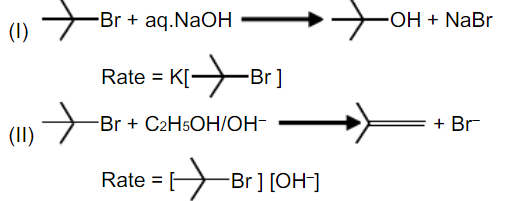PhCHO + HCHO Conc.KOH−−−−−→
Correct statement regarding reaction will be
It is an example of redox reaction
H CHO is oxidised
It is cross cannizaro reaction
Ph–CHO is reduced
The correct Answer is:A, B, C, D
To solve the question regarding the reaction of benzaldehyde (PhCHO) and formaldehyde (HCHO) in the presence of concentrated KOH, we will analyze the reaction step by step.
1. Understanding the Reaction:
- The reaction between benzaldehyde (PhCHO) and formaldehyde (HCHO) in the presence of concentrated KOH is known as the Cannizzaro reaction. This reaction occurs when aldehydes that do not have alpha-hydrogens undergo disproportionation.
Hint: Remember that Cannizzaro reactions typically involve aldehydes without alpha-hydrogens.
2. Identifying Reactivity:
- In this reaction, formaldehyde is more reactive than benzaldehyde due to the absence of resonance stabilization in formaldehyde. Therefore, KOH will preferentially attack formaldehyde.
Hint: Consider the stability of the resonance structures when comparing reactivity.
3. Mechanism of the Reaction:
- The hydroxide ion (OH⁻) from KOH attacks the carbonyl carbon of formaldehyde (HCHO), leading to the formation of an alkoxide intermediate (HCO⁻).
- This alkoxide can then undergo further reaction with benzaldehyde.
Hint: Focus on the nucleophilic attack of the hydroxide ion on the carbonyl carbon.
4. Formation of Products:
- The alkoxide from formaldehyde attacks the carbonyl carbon of benzaldehyde, resulting in the formation of a new alkoxide intermediate.
- This intermediate can then undergo protonation (hydrolysis) to yield an alcohol (from benzaldehyde) and a carboxylic acid (from formaldehyde).
Hint: Keep track of the oxidation states of the carbon atoms in the products.
5. Final Products:
- The final products of the reaction are:
- Benzyl alcohol (from benzaldehyde)
- Formic acid (from formaldehyde)
Hint: Identify the functional groups in the products to confirm their identities.
6. Redox Nature of the Reaction:
- In this reaction, formaldehyde is oxidized to formic acid, while benzaldehyde is reduced to benzyl alcohol. This indicates that the reaction is a redox reaction.
Hint: Remember that oxidation involves an increase in oxidation state, while reduction involves a decrease.
7. Conclusion:
- The correct statements regarding the reaction are:
- Formaldehyde is oxidized to formic acid.
- Benzaldehyde is reduced to benzyl alcohol.
- The reaction is a redox reaction.
Hint: Summarize the key transformations that occur in the reaction to identify the correct statements.
Summary of Correct Statements:
- Formaldehyde is oxidized.
- Benzaldehyde is reduced.
- The reaction is a redox reaction.
Final Answer:
All statements regarding the reaction are correct.
- The reaction between benzaldehyde (PhCHO) and formaldehyde (HCHO) in the presence of concentrated KOH is known as the Cannizzaro reaction. This reaction occurs when aldehydes that do not have alpha-hydrogens undergo disproportionation.
- In this reaction, formaldehyde is more reactive than benzaldehyde due to the absence of resonance stabilization in formaldehyde. Therefore, KOH will preferentially attack formaldehyde.
- The hydroxide ion (OH⁻) from KOH attacks the carbonyl carbon of formaldehyde (HCHO), leading to the formation of an alkoxide intermediate (HCO⁻).
- This alkoxide can then undergo further reaction with benzaldehyde.
- The alkoxide from formaldehyde attacks the carbonyl carbon of benzaldehyde, resulting in the formation of a new alkoxide intermediate.
- This intermediate can then undergo protonation (hydrolysis) to yield an alcohol (from benzaldehyde) and a carboxylic acid (from formaldehyde).
- The final products of the reaction are:
- Benzyl alcohol (from benzaldehyde)
- Formic acid (from formaldehyde)
- In this reaction, formaldehyde is oxidized to formic acid, while benzaldehyde is reduced to benzyl alcohol. This indicates that the reaction is a redox reaction.
- The correct statements regarding the reaction are:
- Formaldehyde is oxidized to formic acid.
- Benzaldehyde is reduced to benzyl alcohol.
- The reaction is a redox reaction.
- Formaldehyde is oxidized.
- Benzaldehyde is reduced.
- The reaction is a redox reaction.
All statements regarding the reaction are correct.
Topper's Solved these Questions
- CARBONL COMPOUNDSBook:MOTIONChapter:CARBONL COMPOUNDSExercise:EXERCISE - 3
Explore 10 Videos
- CARBONL COMPOUNDSBook:MOTIONChapter:CARBONL COMPOUNDSExercise:EXERCISE - 4 LEVEL -I
Explore 6 Videos
- CARBONL COMPOUNDSBook:MOTIONChapter:CARBONL COMPOUNDSExercise:EXERCISE - 2 (LEVEL -I)
Explore 46 Videos
- BIOMOLECULES & POLYMERSBook:MOTIONChapter:BIOMOLECULES & POLYMERSExercise:EXERCISE - 4 (LEVEL II)
Explore 17 Videos
- CARBOXYLIC ACIDBook:MOTIONChapter:CARBOXYLIC ACIDExercise:Exercise - 4 (LEVEL - 2 )
Explore 22 Videos
Similar Questions
Knowledge Check

Correct statement regarding these two reaction I and IIARate of I reaction remain unchanged if concentration of OH− increases.BRate of II reaction remain unchanged if concentration of OH− increases.CRate of both reactions become double if concentration of OH− become doubleDRate of both reactions donot depend upon concentration of OH−
The correct statement(s) regarding the above reaction is/areAmore than catalytic amounts of AlCl3 is required for the reactionBCommonly observed rate =k[Ar−H][RCOCl][AlCl3]CThe electrophile in the reaction R−⊕C=0DIf in RCOCl 'R' is (CH3)3C− the product of the reaction is

Choose the correct statements regarding above reaction:AProduct A is optically activeBThe conversion of alkene to product B is a stereospecific reaction.CProduct B has chiral moleculeDFormation of 'A' is syn addition reaction
_S01_475_Q01.png) Conc.H2SO4−−−−−−−→(A)
Conc.H2SO4−−−−−−−→(A)
View Solution
(1)Cl2/U.V.−−−−−−−−−−−→(2)aq.KOHA50%NaOH−−−−−−→B
The correct statement regarding B is -
View Solution2Al+N2→XH2O−−→Y+Z↑⏐⏐
Correct statement regarding Y
View SolutionChosse the correct statements regarding the following reaction:

View SolutionChosse the correct statements regarding the following reaction:

View Solution



